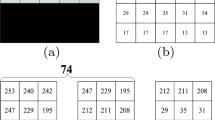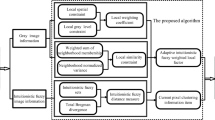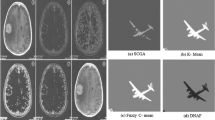Abstract
Accurate segmentation is the basis of object detection, computer vision and other fields. However, the complexity of images, together with the existence of noise and other image artifacts, makes image segmentation still a bottleneck. In this paper, a dynamic relatedness model is presented and an improved fuzzy clustering algorithm is proposed. Compared with traditional algorithms, the relatedness model is measured in the process of image segmentation, and can avoid the effect of inaccurate features in noisy images. With the help of the proposed relatedness, more accurate information can be adopted to enhance the results. Simulated experiments on various images demonstrate that the proposed algorithm can achieve satisfying results and is insensitive to noise of different types.














Similar content being viewed by others
Explore related subjects
Discover the latest articles and news from researchers in related subjects, suggested using machine learning.References
Pham, D.: Robust fuzzy segmentation of magnetic resonance images. In: Proceedings of 14th IEEE Symposium on Computer-Based Medical Systems, (2001), pp. 127–131. https://doi.org/10.1109/CBMS.2001.941709
Roy, S., Agarwal, H., Carass, A., Bai, Y., Pham, D. L., Prince, J. L.: Fuzzy c-means with variable compactness. In: 2008 5th IEEE International Symposium on Biomedical Imaging: From Nano to Macro, (2008), pp. 452–455. https://doi.org/10.1109/ISBI.2008.4541030
Yu, X., Liu, H., Wu, Y., Ruan, H.: Kernel-based low-rank tensorized multiview spectral clustering. Int. J. Intell. Syst. 36(2), 757–777 (2021). https://doi.org/10.1002/int.22319
Zhang, F., Li, J., Liu, P., Fan, H.: Computing knots by quadratic and cubic polynomial curves. Comput. Vis. Media 6(4), 417–430 (2020). https://doi.org/10.1007/s41095-020-0186-4
Bhandari, A.K., Singh, V.K., Kumar, A., Singh, G.K.: Cuckoo search algorithm and wind driven optimization based study of satellite image segmentation for multilevel thresholding using kapur’s entropy. Expert Syst. Appl. 41(7), 3538–3560 (2014). https://doi.org/10.1016/j.eswa.2013.10.059
Kumawat, A., Panda, S.: A robust edge detection algorithm based on feature-based image registration (fbir) using improved canny with fuzzy logic (icwfl). Vis. Comput. (2021) 1–22 https://doi.org/10.1007/s00371-021-02196-1
Aboutabit, N.: A new construction of an image edge detection mask based on caputo-fabrizio fractional derivative. Vis. Comput. 37, 1545–1557 (2021). https://doi.org/10.1007/s00371-020-01896-4
Xiao, C., Gan, J., Hu, X.: Fast level set image and video segmentation using new evolution indicator operators. Vis. Comput. 29, 27–39 (2013). https://doi.org/10.1007/s00371-012-0672-5
Zhang, Y., Guo, Q., Zhang, C.: Simple and fast image superpixels generation with color and boundary probability. Vis. Comput. 37, 1061–1074 (2021). https://doi.org/10.1007/s00371-020-01852-2
Zhang, X., Wang, H., Zhang, Y., Gao, X., Wang, G., Zhang, C.: Improved fuzzy clustering for image segmentation based on a low-rank prior, Computational Visual. Media 7, 513–528 (2021). https://doi.org/10.1007/s41095-021-0239-3
Hu, W., Chen, C., Ye, F., Zheng, Z., Du, Y.: Learning deep discriminative representations with pseudo supervision for image clustering. Inf. Sci. 568, 199–215 (2021). https://doi.org/10.1016/j.ins.2021.03.066
Zhao, F., Jiao, L., Liu, H., Gao, X.: A novel fuzzy clustering algorithm with non local adaptive spatial constraint for image segmentation. Signal Process. 91(4), 988–999 (2011). https://doi.org/10.1016/j.sigpro.2010.10.001
Liu, X., Zhang, Y., Bao, F., Shao, K., Sun, Z., Zhang, C.: Kernel-blending connection approximated by a neural network for image classification. Comput. Vis. Media 6(7), 1–10 (2020). https://doi.org/10.1007/s41095-020-0181-9
Ma, D., Zhou, Y., Xin, S., Wang, W.: Convex and compact superpixels by edge-constrained centroidal power diagram. IEEE Trans. Image Process.https://doi.org/10.1109/TIP.2020.3045640
Wu, C., Zhang, X.: Total bregman divergence-based fuzzy local information c-means clustering for robust image segmentation. Appl. Soft Comput. 94, 106468 (2020). https://doi.org/10.1016/j.asoc.2020.106468
Gong, M., Liang, Y., Shi, J., Ma, W., Ma, J.: Fuzzy c-means clustering with local information and kernel metric for image segmentation. IEEE Trans. Image Process. 22(2), 573–584 (2013). https://doi.org/10.1109/TIP.2012.2219547
Ahmed, M.N., Yamany, S.M., Mohamed, N., Farag, A.A., Moriarty, T.: A modified fuzzy c-means algorithm for bias field estimation and segmentation of mri data. IEEE Trans. Med. Imaging 21(3), 193–199 (2002). https://doi.org/10.1109/42.996338
Szilagyi, L., Benyo, Z., Szilagyi, S. M., Adam, H. S.: Mr brain image segmentation using an enhanced fuzzy c-means algorithm. In: Proceedings of the 25th Annual International Conference of the IEEE Engineering in Medicine and Biology Society (IEEE Cat. No.03CH37439), Vol. 1, (2003), pp. 724–726. https://doi.org/10.1109/IEMBS.2003.1279866
Zheng, Y., Jeon, B., Xu, D., Wu, Q.J., Zhang, H.: Image segmentation by generalized hierarchical fuzzy c-means algorithm. J. Intell. Fuzzy Syst. 28(2), 961–973 (2015). https://doi.org/10.3233/IFS-141378
Cai, W., Chen, S., Zhang, D.: Fast and robust fuzzy c-means clustering algorithms incorporating local information for image segmentation. Pattern Recogn. 40(3), 825–838 (2007). https://doi.org/10.1016/j.patcog.2006.07.011
Krinidis, S., Chatzis, V.: A robust fuzzy local information c-means clustering algorithm. IEEE Trans. Image Process. 19(5), 1328–1337 (2010). https://doi.org/10.1109/TIP.2010.2040763
Benaichouche, A., Oulhadj, H., Siarry, P.: Improved spatial fuzzy c-means clustering for image segmentation using pso initialization, mahalanobis distance and post-segmentation correction. Digital Signal Process. 23(5), 1390–1400 (2013). https://doi.org/10.1016/j.dsp.2013.07.005
Gong, M., Zhou, Z., Ma, J.: Change detection in synthetic aperture radar images based on image fusion and fuzzy clustering. IEEE Trans. Image Process. 21(4), 2141–2151 (2012). https://doi.org/10.1109/TIP.2011.2170702
Zhang, X., Sun, Y., Wang, G., Guo, Q., Chen, B.: Improved fuzzy clustering algorithm with non-local information for image segmentation. Multimedia Tools Appl. 76(6), 7869–7895 (2016). https://doi.org/10.1007/s11042-016-3399-x
Zhang, X., Sun, Y., Liu, H., Hou, Z., Zhao, F., Zhang, C.: Improved clustering algorithms for image segmentation based on non-local information and back projection. Inf. Sci. 550(6), 129–144 (2021). https://doi.org/10.1016/j.ins.2020.10.039
Chen, S., Zhang, D.: Robust image segmentation using fcm with spatial constraints based on new kernel-induced distance measure. IEEE Trans. Syst. Man Cybernet. Part B (Cybernet.) 34(4), 1907–1916 (2004). https://doi.org/10.1109/TSMCB.2004.831165
Liu, K., Guo, Y., Hong, Q., Wu, Q., Zhang, H.: A new spatial fuzzy c-means for spatial clustering. WSEAS Trans. Comput. 14, 369–381 (2015)
Tripathy, B.K., Basu, A., Govel, S.: Image segmentation using spatial intuitionistic fuzzy c means clustering, in. IEEE Int. Conf. Comput. Intell. Comput. Research 2014, 1–5 (2014). https://doi.org/10.1109/ICCIC.2014.7238446
Gharieb, R.R., Gendy, G.: Fuzzy c-means with a local membership kl distance for medical image segmentation, in. Cairo Int. Biomed. Eng. Conf. (CIBEC) 2014, 47–50 (2014). https://doi.org/10.1109/CIBEC.2014.7020912
Dunn, J.C.: A fuzzy relative of the isodata process and its use in detecting compact well-separated clusters. J. Cybernet. 3(3), 32–57 (1973). https://doi.org/10.1080/01969727308546046
Jaffar, A., Naveed, N., Lodhi, B., Hussain, A.,Mirza, A.: Fuzzy c-means clustering with spatial information for color image segmentation. In: Proceeding of 2009 Third International Conference on Electrical Engineering, (2009), pp. 1–6. https://doi.org/10.1109/ICEE.2009.5173186
Cocosco, C., Kollokian, V., Kwan, R. K. S., Bruce, G.: Brainweb: Online interface to a 3d mri simulated brain database, NeuroImage 5(4)
Besser, H.: Visual access to visual images: The uc berkeley image database project. Libr. Trends 38(4), 120–130 (1990). https://doi.org/10.1016/j.foot.2012.03.009
Ronneberger, O., Fischer, P., Brox, T.: U-net: Convolutional networks for biomedical image segmentation, in: International Conference on Medical image computing and computer-assisted intervention, Springer, (2015), pp. 234–241. https://doi.org/10.1007/978-3-319-24574-4_28
Chen, L.-C., Zhu, Y., Papandreou, G., Schroff, F., Adam, H.: Encoder-decoder with atrous separable convolution for semantic image segmentation, in: Proceedings of the European conference on computer vision (ECCV), (2018), pp. 801–818. arXiv:1802.02611
Tschandl, P., Rosendahl, C., Kittler, H.: The ham10000 dataset, a large collection of multi-source dermatoscopic images of common pigmented skin lesions. Scientific data 5(1), 1–9 (2018). https://doi.org/10.1038/sdata.2018.161
Codella, N., Rotemberg, V., Tschandl, P., Celebi, M. E., Dusza, S., Gutman, D., Helba, B., Kalloo, A., Liopyris, K., Marchetti, M., Kittler, H., Halpern, A.: Skin lesion analysis toward melanoma detection 2018: A challenge hosted by the international skin imaging collaboration (isic) (2019). arXiv:1902.03368
Acknowledgements
This research was funded by NSF of China under Granted Number 61873117, 61903172, 62007017, 62106091, 62176140 and 62171209. The authors also gratefully acknowledge the reviewers’ helpful comments and suggestions, which will improve the presentation significantly.
Author information
Authors and Affiliations
Corresponding author
Additional information
Publisher's Note
Springer Nature remains neutral with regard to jurisdictional claims in published maps and institutional affiliations.
Rights and permissions
About this article
Cite this article
Gao, X., Zhang, Y., Wang, H. et al. A modified fuzzy clustering algorithm based on dynamic relatedness model for image segmentation. Vis Comput 39, 1583–1596 (2023). https://doi.org/10.1007/s00371-022-02430-4
Accepted:
Published:
Issue Date:
DOI: https://doi.org/10.1007/s00371-022-02430-4




